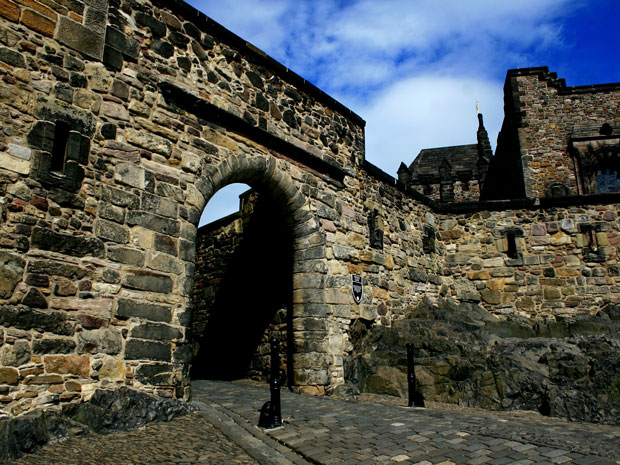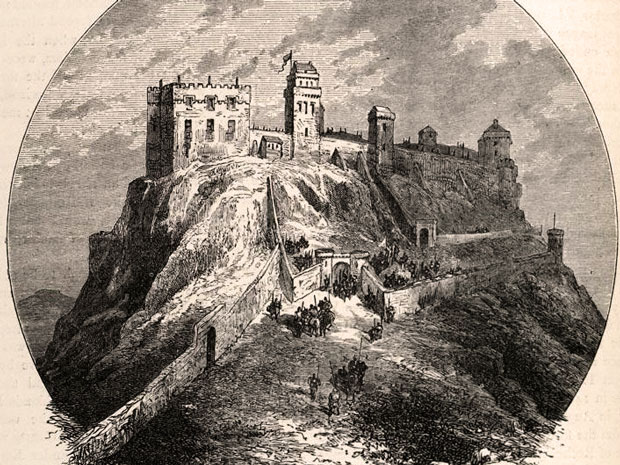Visitors near and far stand in awe of this ancient fortress atop Castle Rock, a towering land formation created from a volcanic plug. The craggy peak has been inhabited since the Bronze Age (900 BC), while records indicate Edinburgh Castle has been in existence since 600 AD. In the epic Welsh poem Y Gododdin, a work that dates back to anywhere between the 7th and early 11th centuries, are references to Din Eidiyn, the stronghold of Edinburgh.
The ancient citadel has since seen its share of sieges, attacks, military occupations, and royal residents. With its history of upheaval, it’s no wonder Edinburgh Castle has been regarded as the most haunted location in Scotland.

Tortured souls from centuries ago reportedly still linger in the castle’s many halls, chambers, and dungeons. Those who wander these passages today report strange sensations such as a sudden drop in temperature and feelings of being watched. Some experience unexplained sounds, a ghostly touch across the face and burning on the arm, or a tugging on one’s clothing. Photographs snapped at the site reveal patches of fog, sometimes colored green.
Such supernatural encounters led a team of nine paranormal researchers to investigate the Scottish castle in 2001. Along with 200 carefully chosen participants—none of whom had prior knowledge of its haunted lore—the team delved into every nook and cranny and reported on what they saw. The verdict? More than half encountered paranormal activity in areas already known to be haunted.
What spirits could be behind this otherworldly activity? For that, we must take a trip through Edinburgh Castle’s haunting past.

The castle’s dungeon has a high degree of paranormal activity. Countless prisoners have been locked up in its cells, suffering torture, malnourishment, and death. More than 500 French prisoners were held here during the Seven Years War and later American colonial captives from the American Revolutionary War.
Many have been lost to time, but one inmate’s tale lives on. A prisoner desperate to escape buried himself in a dung barrow. He made it past the guards, only to meet his death as the barrow’s contents were dumped down the steep, rocky slope of Castle Rock. He makes himself known by trying to push you off the battlements and emanating a strong scent of dung.

The tragic end of one royal captive lives on as well. During the 16th century, Lady Janet Douglas or Lady Glamis was wrongfully accused of witchcraft and burned at the stake as her 16-year-old son watched in horror. She was happily married to the 6th Lord of Glamis until his death in 1528. Alas, King James V considered the Glamis family a threat to his power. Once her husband passed, King James accused Lady Glamis of poisoning him. He tortured and forced false confessions out of her servants and family, seized Glamis Castle (once Queen Elizabeth’s childhood home) and sent her to the castle dungeons to await her execution. She was nearly blind from the subterranean darkness by the time guards brought her to the stake. Hollow knocking can be heard late at night, which some say are the sounds of workers constructing the platform where Lady Glamis was burned alive.

Another hotbed of activity is the Royal Mile, a busy succession of streets that lead through the Old Town to Edinburgh Castle. Below the Royal Mile are underground caverns, unearthed by townsfolk several hundred years ago. A piper playing bagpipes was instructed to explore the tunnels that stretched from High Street to Holyrood House, a place of Scottish royal residence for the likes of Mary, Queen of Scots. He played a tune as he moved deeper into the caves so that others could mark his progress from above.
Then, at about the half-way point, the music abruptly stopped. A rescue party went in to look for the piper, but they found not a trace. If you listen closely while in Edinburgh Castle, you may hear his lonely bagpipes playing from the street above or within the fortress walls.

In addition to these haunting tales, are a bevy of lesser-known spectral figures wandering the castle grounds. Legends tell of a headless drummer from the 17th century who taps upon his snare. The ghostly outline of a man in a leather apron has been seen walking through a doorway in one of the castle’s haunted vaults. Even canines can’t rest easy here. Just beyond the castle entrance, visitors have seen a black hound with a misty glow around it. The dog is believed to be buried in the pet cemetery by the Army Garrison.
The paranormal tales surrounding Edinburgh Castle go on and on. The deeper one wanders down its stone corridors, the more ghosts you’re bound to meet.
All photos: Wikimedia Commons









Share This
Share this post with your friends!